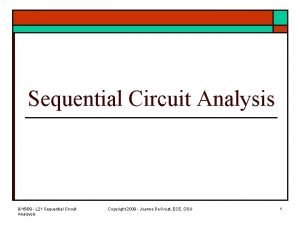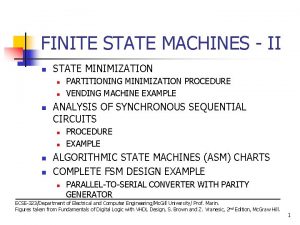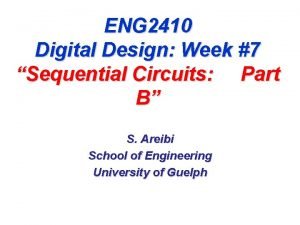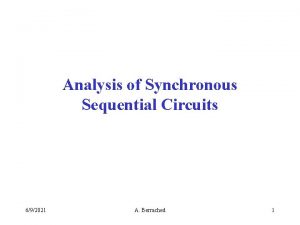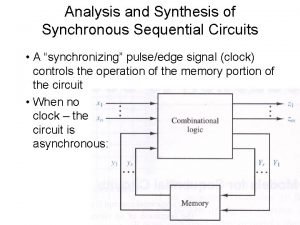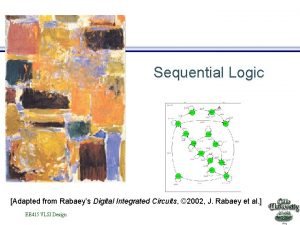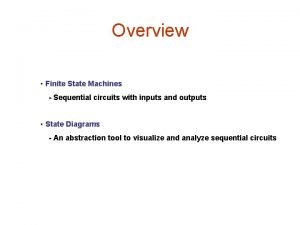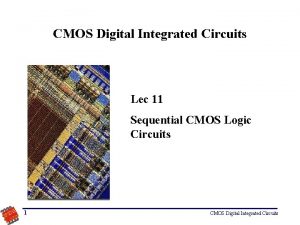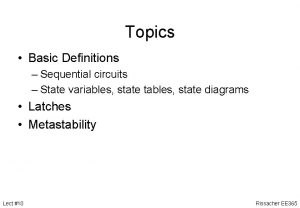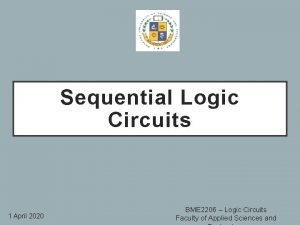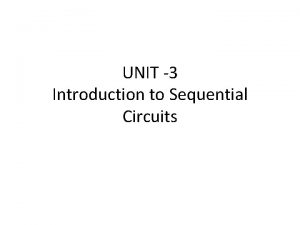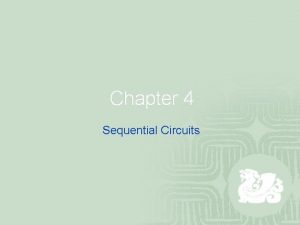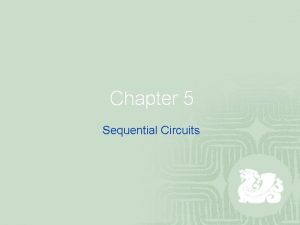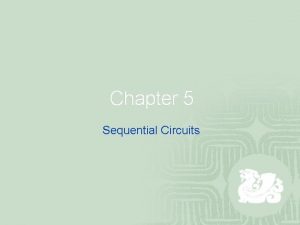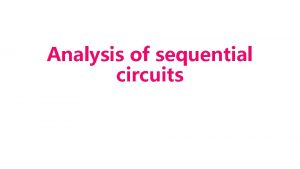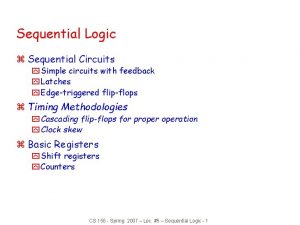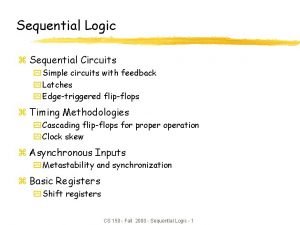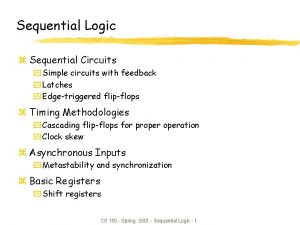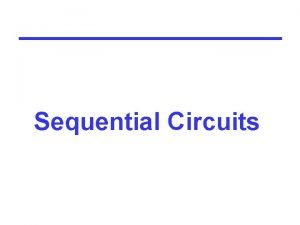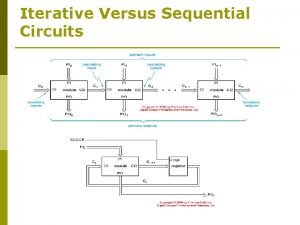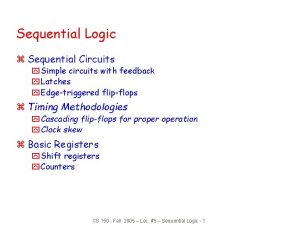Sequential circuits Analysis Design March 16 2020 Patrice













- Slides: 13

Sequential circuits Analysis Design March 16, 2020 Patrice Belleville / Geoffrey Tien 1

Announcements • Classes moved online due to COVID-19 precautions • Midterm 2 will take place ONLINE tomorrow at the scheduled time – Instructions for access, guidelines, and submission will be announced on Piazza • Please pause the recorded video if you need to write anything or we have an exercise • Please bear with the poor lighting and recording quality – this will hopefully improve after I purchase some new equipment March 16, 2020 Patrice Belleville / Geoffrey Tien 2

Exercise Sequential circuit analysis • Determine the behaviour of the following sequential system: March 16, 2020 Patrice Belleville / Geoffrey Tien 3

Sequential circuits Design March 16, 2020 Patrice Belleville / Geoffrey Tien 4

Sequential circuit design • All of the same techniques of design and analysis from combinational circuits also apply to sequential design – Karnaugh maps, recognizers, etc. – Now, the system state (flip-flop outputs) are included as "inputs" • We start with a specification of the states, transitions, inputs, and sequential devices to be used in the construction – based on the understood behaviour of the sequential device (e. g. D flipflop or register), and the required transition, determine the inputs necessary to cause the required transition to occur March 16, 2020 Patrice Belleville / Geoffrey Tien 5

Sequential circuit design • March 16, 2020 Patrice Belleville / Geoffrey Tien 6

Sequential circuit design Sequence generator with reset • Approach 1: individual bits of state implemented using D flipflops – Construct a truth table • current state and external inputs as "input" • next state as "output" • determine propositional logic statements/functions to produce the necessary transition from each current state to the next state. March 16, 2020 Patrice Belleville / Geoffrey Tien 7

Sequential circuit design Sequence generator with reset – approach 1 0 0 0 0 1 1 0 0 0 1 0 1 1 0 0 0 1 1 0 1 0 1 1 0 0 1 1 1 1 0 1 1 March 16, 2020 1 1 Patrice Belleville / Geoffrey Tien 8

Sequential circuit design Sequence generator with reset – approach 1 All signals are 1 bit wide March 16, 2020 Patrice Belleville / Geoffrey Tien 9

Sequential circuit design Sequence generator with reset – approach 2 • Approach 2: Load a register with values from a semantic analysis – Not applicable to this problem • Study the required behaviours, and use combinational components (possibly with feedback loops) to achieve individual functions – E. g. use full adders for addition/increment, use subtractors for subtraction/decrement, etc. • Select between the individual functions using multiplexer(s) March 16, 2020 Patrice Belleville / Geoffrey Tien 10

Sequential circuit design Sequence generator with reset – approach 3 • March 16, 2020 Patrice Belleville / Geoffrey Tien 11

Sequential circuit design Sequence generator with reset – approach 3 Data signals are 2 bits wide March 16, 2020 Patrice Belleville / Geoffrey Tien 12

Sequential circuit design Practice • How to make random practice problems – Decide how many state/input bits you want – From a DFA-like state transition diagram, randomly draw some transitions to various states on specified inputs – Create a truth table from your state transition diagram • There may be some unspecified rows – this is generally OK just for practice and become “don’t-care” rows in your design – see Geoff’s optional Karnaugh map slides from January (between slide sets 05 and 06) March 16, 2020 Patrice Belleville / Geoffrey Tien 13
 Analysis of sequential circuits
Analysis of sequential circuits Vending machine asm chart
Vending machine asm chart Analysis of sequential circuits
Analysis of sequential circuits Analysis of synchronous sequential circuits
Analysis of synchronous sequential circuits Synthesis of synchronous sequential circuits
Synthesis of synchronous sequential circuits Poland national anthem lyrics
Poland national anthem lyrics Non bistable sequential circuits
Non bistable sequential circuits Synchronous sequential circuits examples
Synchronous sequential circuits examples Finite state machine sequential circuits
Finite state machine sequential circuits Non bistable sequential circuits
Non bistable sequential circuits Sequential circuits prelude
Sequential circuits prelude Sequential circuits
Sequential circuits Sequential circuits
Sequential circuits Introduction to sequential circuits
Introduction to sequential circuits
